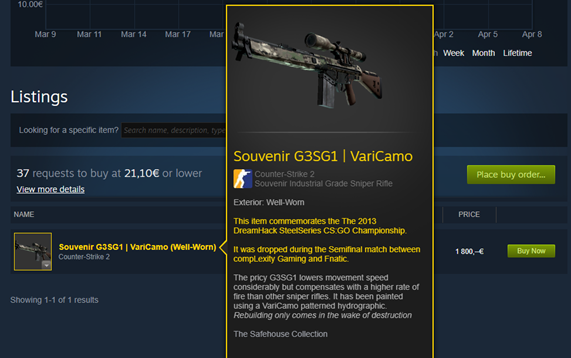A virtual skin, paint made from pixels, can be worth over 150 thousand euros in the first-person shooter Counter-Strike: Global Offensive (CS:GO). With no effect on gameplay, what is the motivation behind spending a lot of money on skins? According to this study, appearance is the bottom line.

Mikko Aallo’s study from 2022 shows that the virtual skin market is the major factor in the success of CS:GO, even though the skins have no impact on the gameplay whatsoever. According to the researcher, microtransactions of buying, selling, and trading skins are important for the game that is nowadays free-to-play. Therefore, it is no surprise that the developer (Valve) has a heavy focus on managing skin-related actions.
The researcher explained that players with thousands of gaming hours have a higher inventory value, meaning that these players are more active with the transactions. The study shows that buying skins is a lot more common activity than trading or case opening, the latter being only 10 percent of obtaining skins. Additionally, Europe is the biggest buyer (per customer) of the four areas included in the study, even though the buyer percentage is higher in Asia. Finally, the study shows that timing is the key element that motivates the buyers. Living market and changing prices set buyers on the move. This means that the value of a skin can be different at different times, for example when bought it can be lower than later on. In addition, the value or rarity of a skin is the clearest buyer attraction because it is a sort of status symbol.
The researcher got an affirmative answer to their question of whether a player who has spent many hours on CS:GO has a higher inventory value than a player who has fewer hours. The results of the study clearly showed that players with 1000–5000 hours and more have an inventory value of over 250 euros. The four areas that were included in the study were Asia, the Americas, the Nordics, and the rest of Europe. Only six percent of the answers were from Asia and almost half, with a 43 percent answer rate, were from Europe (excluding the Nordics). When the researcher combined the answers of whereabouts with the answers of inventory value, they found that European players have the highest inventory values of all.

The results also concluded that buying is a much more popular transaction than trading or selling, for it is the easiest action to perform. Trading was found the most challenging action because there is a possibility of losing a lot of money. Selling as an action is easier, yet it is difficult to get a good price. According to the researcher, this is an understandable motivator for buying skins in CS:GO rather than selling or trading. This result was visible also later in the study when the answers pointed out that the most valuable skins in players’ inventories were usually bought. The researcher emphasizes that these three transactions take place most of the time in third-party marketplaces.
The highest motivator for buying a skin is that the player likes the specific look of a specific weapon. In trading the highest motivator is wanting to switch skins. The reason behind this is that there is an expectation that the value of the new skin will rise later and profit the player. This can be seen also from the biggest motivator towards selling a skin, which is that the value of a skin has risen, and it is profitable to sell it. Furthermore, another popular activity in CS:GO is case opening, which is an in-game skin lottery mechanic. The study found that the feeling of excitement is the main reason cases are opened. In addition, players buy cases and keys when they want to get more expensive skins for their weapons.
Aallo introduces themselves as a Counter-Strike player and a fan of the game series. They wanted to find out what are the main motivators for buying skins – visual decorations for weapons – in CS:GO. They wanted to have answers to the questions of why, how, and when, in relation to this subject. Aallo studied consumer behavior and considered location, age, and play hours. They conducted a Google Forms online questionnaire survey that was shared through a CS-related forum. The responses (239) were analyzed in quantitative means and visualized in graphs and tables. Additionally, the survey included some open-ended questions that were analyzed in qualitative means.
Aallo, M. (2022). The fascination of virtual skins and consumers buying behaviour in Counter Strike Global Offensive. Theseus. https://urn.fi/URN:NBN:fi:amk-2022113025051
Photos: Screenshots from Steam Community Market, Counter-Strike 2 (Valve 2023), taken by the author. The featured image is from the game Counter-Strike 2, also taken by the author.
